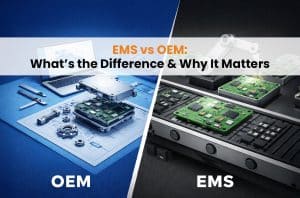In today’s technology and innovation speed world, success is often dependent on having the capacity to iterate fast, test effectively, and get high-quality products to market. For hardware products, particularly in electronics, prototyping is not an optional stage—it’s a necessity. When engaging an EMS company, a properly done prototype can be the difference between a product that’s ready for market and an expensive failure.
Let’s examine how prototyping is a crucial part of electronics manufacturing services, particularly with respect to PCB assembly, design optimization, time-to-market, and long-term reliability.
Why Prototyping is Important in EMS
Prototyping enables developers and engineers to create an operational version of a product prior to mass production. This process allows companies to:
- Test actual-world functionality
- Detect design faults early.
- Test user experience
- Verify component compatibility
For EMS providers, prototyping is a guide to determine the customer’s requirements and give specific feedback that improves a product’s design and manufacturability. Skipping this phase, going directly into production, can cause product recalls, performance problems, or higher production costs because of rework.
Role of PCB Assembly in Prototyping
At the core of any electronic device is its printed circuit board (PCB). Whether you’re building a smart wearable, an automation device for a house, or an industrial controller, PCB assembly is the core of how your product works.
When building prototypes, PCB assembly entails:
- Populating sample boards with selected components
- Testing electrical integrity and signal path
- Evaluating thermal performance
- Checking form factor and mechanical fit
Prototypes with populated PCBs allow engineers to test and verify numerous functionalities. The slightest mistake in layout, soldering, or component positioning can significantly impact performance. That is why EMS partners who have PCB assembly expertise play a vital role by utilizing high-precision machinery and industry experience at this stage.
Advantages of Prototyping with EMS Companies
Working with experienced EMS companies for your prototype ensures more than just manufacturing support. Here’s how it adds strategic value:
1. Design for Manufacturability (DFM) Insights
A reliable EMS partner will suggest modifications that simplify production, reduce costs, and improve yield. For instance, choosing standard components or optimizing PCB layer design can make a product more scalable.
2. Risk Mitigation
Prototyping allows you to identify technical risks and usability problems prior to large-scale production. With electronics manufacturing services, you can model worst-case scenarios and know how your product will hold up under different conditions.
3. Cost Savings
Problem identification and fixing at the prototype phase is much cheaper than doing so after production. EMS providers can assist in optimizing designs to utilize cost-saving materials and simplify assembly processes.
4. Reduced Time-to-Market
Early prototyping and testing speed up product development cycles. When you recognize bottlenecks in the prototype, you can prevent delays in large-scale production. EMS companies tend to use rapid prototyping tools to reduce lead time and speed up validation.
Bridging the Gap Between Concept and Market
A good concept is still an idea until the idea is executed into a usable product. During prototyping, this shift occurs. What you gain with EMS companies is access to infrastructure, engineering expertise, facilities and testing capabilities that can refine your concept into a manufacturable design.
Trustworthy electronics manufacturing services providers include prototyping in their development cycle. Starting from material procurement to trial PCB assembly, they assist in testing everything from the circuit behaviour to the product ergonomics.
Whether it is a single-layer prototype for a basic device or a multi-layer high-speed board for intricate systems, the prototyping phase guarantees that the final product will comply with both market and regulatory requirements.
Conclusion:
Prototyping is not a choice in today’s competitive environment—it’s a requirement. It enables companies to create with confidence, assured that they are working from a proven design. Working with capable EMS providers guarantees that your prototypes are constructed to professional specifications, paving the way for the turnkey transition to production volume.
By tapping into the complete range of electronics manufacturing services, from PCB assembly to end testing, you risk less, save dollars, and guarantee product success.
Then, before you ship, prototype. and prototype intelligently—with the correct EMS provider at your side.


